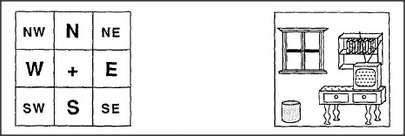


Whenever we see a thing so utterly new that it resembles nothing we've ever seen before, this means that none of our prelearned frames will fit it very well. But this rarely happens to adults. For example, we have each accumulated enough room-frames to represent most rooms we're likely to see, such as kitchens, bedrooms, offices, factories, and concert halls; one of these will usually match whichever place we happen to be. Besides, we can almost always use a less specific frame that fits most any room at all — a frame with terminals that correspond to nothing more than ceiling, floor, and walls. Then each of those six surfaces could be represented, in turn, by a subframe that has terminals for several vaguely defined regions. To be specific, let's employ our direction-neme idea and divide each surface — for ceiling, floor, and each of the walls — into zones that correspond to the nine regions of an interaction-square. A typical wall might then be represented in this fashion:

In spite of its simplicity, we can represent quite a lot of information with this scheme. It provides enough structure to recall later that there was a window toward the left, some shelves high to the right side of the wall, and a table to the right. If this does not seem precise enough, the fact is that we usually don't remember things so exactly, except when they attract special attention; normally it would be enough to know only roughly where that television was, and we could assume by default that it was supported by the tabletop. It takes surprisingly few such observations to enable us to tell, later, whether much has been changed.
Given more time, one could keep noticing more details and include them by attaching additional subframes. This would overcome the limitations of starting with so few terminals. For example, one might notice that the window is closer to the shelf than to the television set, and closer to the ceiling line than to either the shelf or the television set. And if the outline of the desk and television set reminds you of a goatlike animal, your representation can include that fact.
Suppose you had first assumed this to be a living room but later recognized the table to be a kitchen table? Must you undo all the work you've done, to activate a different kitchen-frame and start all over again? No, because later we'll see a convenient way to switch over to another frame — while still retaining what was learned so far. The trick will be to make all our frames for different rooms share the same terminals, so that when we interchange those frames, the information stored in them remains.